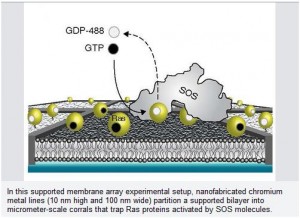The Ras family of proteins is one of the most important components of cellular signaling networks in biology and major drivers of cancers. Recently, scientists with the U.S. Department of Energy (DOE)’s Lawrence Berkeley National Laboratory (Berkeley Lab) and the University of California (UC) Berkeley, have unlocked the secret behind the activation of the Ras family.
The cellular signaling networks of living cells start with receptor proteins residing on a cell’s surface that detect and interact with the environment. Signals from these receptors are transmitted to chemical networks within the cell that process the incoming information, make decisions, and direct subsequent cellular activities. Ras proteins are essential components of signaling networks that control cellular proliferation, differentiation and survival. Mutations in Ras genes were the first specific genetic alterations linked to human cancers and it is now estimated that nearly a third of all human cancers can be traced to something going wrong with Ras activation. Defective Ras signaling has also been cited as a contributing factor to other diseases, including diabetes and immunological and inflammatory disorders. Despite this long history of recognized association with cancers and other diseases, Ras proteins have been dubbed “un-druggable,” largely because their activation mechanism has been poorly understood.
Overcame the challenge in the experiment. They know the activation mechanism of Ras family. The outcome can be directly determined by the process of averaging. Even though the behavior of an individual protein is intrinsically variable, the average behavior from a large group of identical proteins is precisely determined by molecular level probabilities. Ras activation in a living cell, however, involves a relatively small number of SOS molecules, making it impossible to average the variable behavior of the individual molecules. This variation is referred to as stochastic “noise” and has been widely viewed by scientists as an error a cell must overcome.
This article is extract from http://www.sciencedaily.com/releases/2014/07/140703151823.htm





